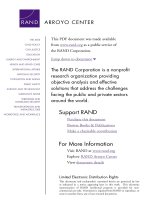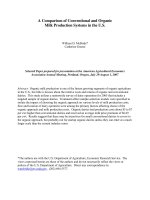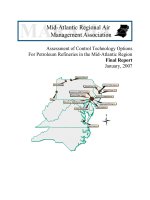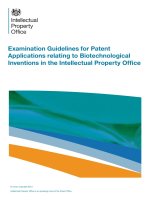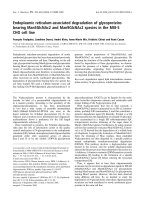USE OF BIOMETRIC IDENTIFICATION TECHNOLOGY TO REDUCE FRAUD IN THE FOOD STAMP PROGRAM: FINAL REPORT docx
Bạn đang xem bản rút gọn của tài liệu. Xem và tải ngay bản đầy đủ của tài liệu tại đây (426.13 KB, 121 trang )
Contract No: FCS 53-3198-6-025
Use of Biometric Technology to Reduce
Fraud in the Food Stamp Program
USE OF BIOMETRIC IDENTIFICATION TECHNOLOGY
TO REDUCE FRAUD IN THE FOOD STAMP PROGRAM:
FINAL REPORT
December 1999
Authors:
Paul J. Sticha
R. Lewis & Company, Inc.
David Thomas
Chris Zamberlan
Caliber Associates
Monica A. Gribben
R. Lewis & Company, Inc.
Submitted to:
U.S. Department of Agriculture
Food and Nutrition Service
3101 Park Center Drive
Alexandria, VA 22302
Project Officer:
Sharron Cristofar
Submitted by:
R. Lewis & Company, Inc.
1235 Jefferson Davis Highway
Suite 606
Arlington, VA 22202
Project Director:
Paul J. Sticha
NON-DISCRIMINATION POLICY
The U.S. Department of Agriculture (USDA) prohibits discrimination in all its programs and
activities on the basis of race, color, national origin, gender, religion, age, disability, political
beliefs, sexual orientation, or marital or family status. (Not all prohibited bases apply to all
programs.) Persons with disabilities who require alternative means for communication of
program information (Braille, large print, audiotape, etc.) should contact USDA’s TARGET
Center at (202) 720-2660 (voice and TDD).
To file a complaint of discrimination, write USDA, Director, Office of Civil Rights, Room 326-W,
Whitten Building, 14
th
and Independence Avenue, S.W., Washington D.C. 20250-9419 or call
(202) 720-5964 (voice and TDD). USDA is an equal opportunity provider and employer.
i
ACKNOWLEDGMENTS
The authors acknowledge the contributions of the State officials who shared their time and
knowledge with us, and provided us much of the information that is summarized in this report.
Officials from Arizona, California, Connecticut, Illinois, New Jersey, New York, and Pennsylvania
participated in 1-2 hour interviews to discuss all phases of their projects. In an earlier task, we
conducted site visits to San Antonio, Texas to observe the Lone Star Image System
demonstration and to interview State and county agency staff. In addition to participating in the
survey, the State representatives provided written documentation and were available to answer
many follow-up questions to clarify the accomplishments of their offices.
We also thank Sharron Cristofar, the project officer from Food and Nutrition Service, who
provided guidance throughout the project. This report has benefited from the thoughtful
comments of Steven Carlson and Cecilia Fitzgerald. Judith Barokas, of Consulting Research and
Information Services, developed the interview guides used for the client advocate interviews.
ii
iii
TABLE OF CONTENTS
EXECUTIVE SUMMARY vii
1. INTRODUCTION 1
1.1 Increasing the Integrity of the Food Stamp Program 1
1.2 Biometric Identification in Social Services 2
Expansion of Biometric Identification 3
Assistance Programs Subject to Biometric Requirements 5
1.3 Organization of This Report 5
2. STATE INTERVIEWS 9
2.1 State Selection and Data Collection Methods 9
2.2 Interview Results: Planning and Implementation 10
Impetus and Technology Selection 10
State Planning Activities 10
Implementation 12
Modifications to State Systems 14
Organization and Staffing 15
Vendor Role 15
Staff Preparation and Training 16
Informing Clients and the General Public 17
2.3 Interview Results: Policy and Procedure 17
Mandatory Participants and Exemptions 18
Match Response 20
Binning and Filtering 21
2.4 Interview Results: Ongoing Operations 22
Types of Matches and Investigations 22
Office and Client Burden 22
Technical Problems 23
3. IMPACT OF FINGER IMAGING 25
3.1 Detected Fraud 26
3.2 Refusals to Comply with Finger-image Requirements 28
3.3 Reduction in Applications or Caseload 31
3.4 Summary 33
iv
4. DETERRENT EFFECTS OF FINGER IMAGING ON ELIGIBLE INDIVIDUALS 35
4.1 Client Reactions 35
4.2 Former Client Interviews 37
4.3 Client Advocate Opinions 37
4.4 Summary 39
5. COST ANALYSIS OF FINGER IMAGING IN THE FSP 41
5.1 Review of State Costs Estimates 41
5.2 Elements of Implementation and Operating Cost 43
5.3 Quantifying the Benefits of Finger Imaging 45
5.4 Summary 46
6. SUMMARY, CONCLUSIONS, AND DISCUSSION 49
6.1 Summary of Findings 49
6.2 Biometric Technology, Welfare Reform and Assessment of Duplicate Participation50
6.3 Future Developments 52
REFERENCES 53
APPENDIX A. STATE STAFF INTERVIEW GUIDE A-1
APPENDIX B. PROFILES OF STATE FINGER-IMAGING SYSTEMS B-1
APPENDIX C. REPORT OF CLIENT ADVOCATE INTERVIEWS C-1
APPENDIX D. CLIENT ADVOCATE INTERVIEW PROTOCOL D-1
List of Tables
Table 1. Enabling Legislation for Biometric Systems 11
Table 2. Start-Up and Implementation Description 13
Table 3. Mandatory Participants by Assistance Program and Allowable Exemptions 19
Table 4. Match Response Time 21
v
Table 5. Finger-image Matches Attributed to Fraud 27
Table 6. Refusals of Existing Cases to Participate in Finger Imaging 29
Table 7. Summary of Client Survey Results 36
Table 8. Three-Year Cost Estimates for Finger Imaging 42
Table 9. Cost Elements Included in State Estimates 44
List of Figures
Figure 1. Current and planned biometric identification systems in the U.S. (November 1998) 7
Figure 2. Food Stamp and TANF/AFDC households, 1993-1997 32
vi
vii
EXECUTIVE SUMMARY
Biometric identification technology provides automated methods to identify a person
based on physical characteristics—such as fingerprints, hand shape, and characteristics of the eyes
and face—as well as behavioral characteristics—including signatures and voice patterns.
Although used in law enforcement and defense for several years, it has recently been used in
civilian applications and shows some promise to reduce the number of duplicate cases in the Food
Stamp Program (FSP) and other assistance programs (GAO, 1995).
Biometric identification systems are currently operational at some level in Arizona,
California (under county initiative, first by Los Angeles County), Connecticut, Illinois,
Massachusetts, New Jersey, New York, and Texas. Finger imaging is the principal form of
technology used in all eight States, though alternative technologies have simultaneously
undergone trials in Massachusetts (facial recognition) and Illinois (retinal scanning). By the end
of 2000, new systems are expected to be in place in California (statewide unified system),
Delaware, and North Carolina. Other States are currently in the initial planning stages, including
Florida, Maryland, Michigan, Mississippi, Pennsylvania, and South Carolina. However, there is
little information available at this point regarding the specific course and trajectory these States
will follow in terms of system types, implementation schedules, and the benefit programs in which
they will implement the new requirement.
This report provides an overview of the experience of nine States with biometric
identification technologies as of September 1999 and discusses some of the major policy and
operational issues encountered during implementation and testing. The report also synthesizes
available information on the effectiveness of the technology in reducing duplicate participation
and provides a discussion of measurement complexities and issues on the horizon as use of the
technology continues to expand. A companion report (Sticha & Ford, 1999) contains an
overview of biometric identification technology, examining the functional capabilities,
performance, and applications of the various technologies with a particular focus on finger
imaging, the most commonly used and well known.
Telephone interviews of 1-2 hours in duration were conducted in May-June 1998 with
representatives of human service agencies in Arizona, California, Connecticut, Illinois,
Massachusetts, New Jersey, New York, and Pennsylvania. As part of an earlier task of this
study, we conducted site visits to San Antonio, Texas to observe the Lone Star Image System
(LSIS) demonstration and to interview State and county agency staff. Information on Texas is
based on those visits and interviews. The States interviewed, with the exception of Pennsylvania,
have installed biometric identification systems and are requiring applicants to federal and State
benefit programs to submit to the new procedures during the eligibility determination process.
The purpose of the interviews was to explore State experiences with biometric
identification systems, including factors in the decision-making and planning processes, the
dynamics of system start-up and implementation, issues and problems related to system and
agency operations, and perceptions regarding the impact of biometric identification procedures on
the application and eligibility determination processes. Each of the States participating in the
viii
study was asked to provide a description of the critical early events that occurred during the
planning phases of their respective projects. In addition, those States that had already
implemented systems were asked to describe their implementation experiences.
Results of State Interviews
When finger-imaging technology was first applied to reduce multiple participation fraud in
assistance programs, there were many concerns about the performance and reliability of the
technology in a social service application, as well as about the potential stigma that a finger-image
requirement would place on potential clients. The experience of the eight States that have
incorporated finger imaging into the process of applying for welfare assistance suggests that many
of these fears were unfounded. Finger imaging has been readily integrated into the human
services programs of the affected states. However, despite the positive reaction to finger imaging
from the State officials we interviewed, there is still uncertainty regarding the extent to which this
technology can reduce multiple participation fraud.
The States planned for implementation of their biometric identification systems in response
to a wide variety of factors and considerations idiosyncratic to each State environment. Some
States reported that their respective legislative mandates, which prescribed specific dates by which
biometric systems were required to be in place, allowed insufficient time for development and
planning. The States developed and followed implementation schedules in accordance with
internal priorities and considerations. The States uniformly described their implementation
processes as largely uneventful, though they encountered a variety of minor implementation
issues, most of which were associated with the logistical difficulties of mobilizing and managing
such a complex initiative.
Preparing staff for the implementation of the biometric systems, both philosophically and
operationally, took different forms, priorities, and levels of effort in the States. At
implementation, advance notification to clients and/or the general public about new biometric
client identification procedures was considered important by all State representatives. The
objective of providing advance notification was to inform and prepare clients for the additional
application or recertification step (i.e., to explain the requirement and who is required to submit,
and to address client concerns), as well as to accelerate enrollment of the existing caseload. All
States prepared informational mailings to clients advising them of the new requirement. Some
States reported developing additional outreach media including multilingual (English and Spanish)
videos, posters, and brochures for viewing and distribution in the local office. Most of the States
also identified various outlets in the community through which they informed the general public in
advance about the implementation of biometric client identification procedures.
The States with operating systems reported that implementation of new biometric client
identification procedures had a negligible impact on operations at the local office level. In
general, States also reported that the problems and obstacles encountered in operating their
respective projects are not unlike those encountered in demonstrating any new technology or
procedural modification. These States also reported that their systems and procedures were
implemented without unexpected difficulty and were rapidly institutionalized. All the States
confronted a range of basic physical space and logistical issues, including where to situate the new
ix
equipment, how to appropriately alter job descriptions, who to reassign or hire to handle the new
procedures, and how to adjust the flow of clients and paperwork most efficiently. However, none
reported any particularly noteworthy difficulties. States reported that clients have been
cooperative and accepting of the technology.
Finger Imaging and Fraud Reduction
Assessing the ability of finger imaging to reduce fraud is difficult because the amount of
fraud caused by duplicate participation in welfare programs is unknown, and because changes in
caseload after the introduction of finger imaging cannot be interpreted unambiguously as
reduction of fraud. The evaluations of finger imaging systems conducted by six States have
produced the following findings.
• A small number of duplicate applications (approximately 1 duplicate for every 5,000
cases) have been detected by finger imaging systems. Finger-imaging systems appear to
detect more fraud in statewide implementations than in regional pilot systems. Additional
matches have been found by interstate comparisons of finger-image data.
• Institution of a finger-imaging requirement can produce a significant, short-term reduction
in caseload, because some existing clients refuse to comply with the requirement. The
number of refusals depends on the implementation procedures and appears to be lower
when finger imaging is incorporated into the recertification process.
• The most carefully controlled estimate of non-compliance among existing clients suggests
that introduction of a finger-imaging requirement reduces participation by approximately
1.3%. However, this estimate reflects both reduced fraud and deterrence of eligible
individuals and households.
Finger Imaging as a Deterrent to Legitimate Participants
Clients do have some concerns about finger imaging. Roughly 15% expressed concerns in
the State surveys and interviews conducted to evaluate finger-imaging programs. These concerns
center on issues of privacy, unjust treatment of poor people, inconvenience, and fear of
interagency sharing.
There is little data on which to estimate the size of the deterrence effect. Based on the
results from client surveys in five States, a substantial majority of clients had no objection to
finger imaging and thought it was a good idea.
There was little evidence that clients discontinued benefits because they were intimidated
by the finger-image requirement. Interviews with former clients in Texas found that only two of
the 78 former food stamp recipients (both of whom had refused to be imaged) attributed their loss
of benefits to finger imaging. Similar interviews in Los Angeles County found that, of those
former clients interviewed, no one who refused to be finger imaged expressed a concern with the
process.
x
Cost and Effectiveness of Finger Imaging
Since there is no reliable estimate of the magnitude of duplicate participation in the FSP,
there is uncertainty regarding the cost effectiveness of finger imaging. Available data are
inadequate to make precise estimates of either the costs or benefits of finger imaging for the FSP.
Calculations using the data that are available, supplemented by a number of assumptions, suggest
that reduction in caseload covers the costs of finger imaging technology. However, the
percentage of the caseload reduction due to decreased multiple participation is unclear.
The analysis makes no assumption about how costs or benefits are allocated among Federal
or State agencies. In addition, it does not include the cost required to modify existing software to
make it compatible with the finger-imaging system. Finally, it does not take into account that
certain cost elements, such as the cost for infrastructure or centralized equipment, may be
independent of caseload fluctuation.
1
1. INTRODUCTION
This report provides an overview of the experiences of nine States with biometric
identification as of September 1999, and discusses some of the major policy and operational issues
encountered during implementation and testing. The report also synthesizes available information
on the effectiveness of the technology in reducing duplicate participation and provides a
discussion of measurement complexities and issues on the horizon as the use of this technology
continues to expand. A companion report contains an overview of biometric identification
techniques, examining the functional capabilities, performance, and applications of the various
technologies with a particular focus on finger imaging, the most commonly used and well known
(Sticha and Ford, 1999).
1.1 Increasing the Integrity of the Food Stamp Program
The Food Stamp Program (FSP) provided more than $16.9 billion in benefits to over 19
million individuals in 1998. As part of its ongoing effort to increase program integrity, the Food
and Nutrition Service (FNS) monitors the level of food stamp overpayments and has developed
and promoted procedures to prevent households from obtaining benefits to which they are not
entitled.
The overall level of food stamp overpayment is estimated by FNS in its annual quality
control review. Summarizing these reviews, the General Accounting Office (GAO, 1997, 1998a)
reported that households receive more benefits than they are entitled to in approximately 15% of
all food stamp cases; these overpayments represent 7% of the benefits that are issued.
Approximately one-quarter of these overpayments were judged to be caused by intentional
program violations by clients (GAO, 1994). The report enumerates four potential sources of
fraud, waste, and abuse in the FSP: (1) The eligibility and benefit determination process, (2) the
use of benefits for nonfood purposes, (3) counterfeiting of food stamp coupons or their use by
unauthorized individuals, and (4) theft or loss of coupons in the mail.
Until recently, investigation of questionable information given by an applicant for food
stamps was a labor-intensive activity that often severely taxed the capabilities of local welfare
offices (GAO, 1997). Furthermore, the resulting information—based on interviews with
employers, landlords, friends and neighbors of the applicant—was often of limited reliability.
Recent technological advances have provided tools that can be used to make fraud more
difficult to commit and easier to detect. For example, the Income Eligibility Verification System
(IEVS), established in 1986, required that case records be matched with six external data bases.
Relevant data bases may contain information about wages, income taxes, unemployment insurance
benefits, or other information that can be used to verify the income or assets of a recipient or
applicant household. A study sponsored by FNS established the cost-effectiveness of IEVS when
appropriate targeting methods were used (Maxfield & Allin, 1995). GAO (1997, 1998b) has
suggested other data bases that can be used to verify the legitimacy of an application for food
stamp aid. These data bases include death records maintained by the Social Security
Administration (GAO, 1998b) and records of prison inmates (GAO, 1997). Comparison of case
2
records to the information in these data bases can help ensure that ineligible individuals are not
included as members of the recipient or applicant household.
The Food Stamp Act as amended [7 CFR 272.4(f)(1)] requires each State agency to
establish a system to assure that no individual participates in the FSP more than once a month, in
more than one jurisdiction, or in more than one household within the State. The system
established to identify such individuals must use identifiers such as names and social security
numbers at a minimum, and may use other identifiers, as the State agency deems appropriate.
Under 7 CFR 272.4(f), the use of finger images and other non-intrusive biometric identifiers is
permissible in fulfilling this requirement.
There are many ways an individual can commit program fraud using duplication of
identity. An individual can apply for and receive concurrent benefits from more than one program
when, in fact, he or she is ineligible or would be eligible for a lower benefit amount, for example.
More specifically, a recipient of benefits under the Temporary Assistance to Needy Families
(TANF) program who is eligible for a fairly low food stamp benefit may apply for food stamps
under another identity, thus fraudulently obtaining the full TANF benefit and the full FSP benefit.
1
To create a fictitious identity, one needs a false birth certificate—created with a fictitious name—
to obtain secondary identification documents from issuing agencies. With these documents, a
person has sufficient identification to obtain assistance concurrently in multiple cases without fear
of detection.
Recent developments in biometric identification technology have potential to provide
positive identification of applicants and recipients of food stamp benefits, and consequently reduce
the level of fraud in the program. This technology provides automated methods to identify a
person based on physical characteristics—such as fingerprints, hand shape, and characteristics of
the eyes and face—as well as behavioral characteristics—including signatures and voice patterns.
Although these technologies have been used in law enforcement and defense for several years,
they have recently been used in civilian applications and show some promise to reduce fraud in the
FSP and other assistance programs (GAO, 1995). This technology has the potential to identify
individuals who attempt to apply for benefits on more than one case, or who attempt to obtain
benefits belonging to someone else.
1.2 Biometric Identification in Social Services
Following a 1983 California Superior Court ruling that prohibited human services agencies
in Los Angeles County from denying aid to applicants without identification, the Los Angeles
County Department of Public Social Services (DPSS) began exploring the use of biometric
identification technology to confront and eradicate the potential for duplicate case fraud
1
Passage of the Personal Responsibility and Work Opportunity Reconciliation Act (PRWORA) in 1996
dismantled the old Aid to Families with Dependent Children (AFDC) program and replaced it with a time-
limited cash assistance program called Temporary Assistance for Needy Families (TANF). The effect of the
legislation was to revoke the entitlement status of the old AFDC program and return administrative control of
basic welfare services to the States, which are now free to design services within broad, federal parameters.
AFDC is used in this report to reference cash assistance prior to implementation of TANF.
3
(DePompa 1997). In 1991, embarking on the first demonstration of its kind in a non-law
enforcement environment, DPSS, in cooperation with Electronic Data Systems (EDS),
implemented the Automated Fingerprint Image Reporting and Match (AFIRM) system and began
fingerprinting all applicants to the county’s General Relief (GR) program, which dispenses
financial assistance to families ineligible for federal or State assistance programs.
Under an agreement with the California Department of Social Services, and with matching
funds from the U.S. Department of Health and Human Services (DHHS), a three-year project
beginning in April 1994 expanded the requirement to the Aid to Families with Dependent Children
program. A review of the AFIRM project conducted by the department’s Office of the Inspector
General (OIG) in 1996 found that the system generated considerable savings that were attributed
to the discontinuance of AFDC and food stamp benefits to a large number of cases in LA County.
The county estimated its total savings to be $86 million (accounting for operating costs), with net
savings estimated to be $66 million. The OIG report indicates that the AFIRM system also had
benefits in the detection of other types of welfare fraud. While investigating a sample of 137
cases in which persons for whom fingerprinting was required failed to show, the county found
evidence of non-multiple case fraud in 63 cases (46% of the cases). These forms of fraud
included concealing income and misrepresenting household composition (DHHS OIG, 1996).
Expansion of Biometric Identification
Since the Los Angeles County experiment, the technological landscape has become more
complex and competitive with the emergence and continuing refinement of alternative biometric
applications, including hand geometry, iris recognition and retinal scanning, voice recognition, and
facial imaging (Lazar, 1997). Encouraged by the performance of the AFIRM system, a number of
other States began exploring the feasibility of finger imaging as well as alternative systems,
pursued enabling legislation, selected systems, and began implementing selected systems in
accordance with legislative mandate.
2
In the wake of the AFIRM experiment, seven States
implemented biometric identification systems, chronologically as follows:
• The New York Department of Social Services, under contract with Sagem-Morpho,
implemented its Automated Finger Imaging System (AFIS) in 38 counties in June 1995,
began an expansion throughout the rest of the State in August 1995, and had a statewide
finger imaging system in place by January 1996.
• The New Jersey Department of Human Services, under contract to The National Registry,
followed in July 1995 with implementation of its Recipient Identification Program (RIP),
which is currently operating in an experimental phase in portions of the northern tier of the
State.
2
The State of California functions under a State-administered, county-operated system in which six counties
followed LA County and implemented biometric systems independently, with State approval. However,
interviews for this study were conducted only at the state level; this report, therefore, does not include
information specific to each of California’s seven counties that currently have independently operating systems.
4
• The Connecticut Department of Social Services implemented its Digital Imaging System
in January 1996, under contract to the Polaroid Corporation (formerly NBS Imaging
Systems) and The National Registry, and completed a statewide roll-out the following
September.
• The Massachusetts Department of Transitional Assistance implemented finger imaging
and facial recognition technology in April 1996, under contract to Viisage Technology,
with a subcontract to The National Registry specifically for the finger imaging component,
and currently is the only State experimenting with a dual platform system.
• The Illinois Department of Human Services implemented its Retinal Identification System
(ISCAN) in May 1996 (discontinued in March 1998), and its Automated Identification and
Match System (AIMS), a finger imaging system, in February 1997, under contract to
Printrak International.
• The Texas Department of Human Services implemented its Lone Star Image System
(LSIS) in October 1996, under contract to Sagem-Morpho, as a two-county
demonstration in the San Antonio metropolitan area (Bexar and Guadalupe). Statewide
implementation of the system was completed in August 1999.
• The Arizona Department of Economic Security implemented the Arizona Fingerprint
Imaging Program (AFIP) in January 1998, under contract to Sagem-Morpho, and
completed a rapid statewide roll-out by July 1998.
As of September 1999, two States were in the very late planning stages and were preparing for
implementation, including:
• In California—a State-administered, county-operated State in which seven counties
implemented biometric systems independently with State approval since 1991—the
California Department of Social Services awarded a contract to implement a statewide,
unified finger imaging system covering all 225 counties in September 1999. Contract
award had been delayed after the request for proposals (RFP) was released in 1997,
recalled, and reissued in 1998.
• The Pennsylvania Department of Public Welfare, which released its original request for
proposals in January 1997 and encountered legal challenges, now expects to release a new
RFP for the Pennsylvania Automated Recipient Identification System (PARIS), a finger
imaging system, by January 2001.
As of September 1999, five States had biometric identification systems operating statewide,
including Arizona, Connecticut, New York, and Texas, which have finger imaging systems, and
Massachusetts, which has a statewide facial matching system in operation. California, Illinois, and
New Jersey currently have systems operating at a pilot capacity in a limited number of
jurisdictions.
5
Other States are currently in the initial planning stages, including Delaware, Florida,
Maryland, Michigan, Mississippi, North Carolina, and South Carolina; however, there is little
information available at this point regarding the specific course and trajectory these States will
follow in terms of system types, implementation schedules, and the benefit programs in which they
will impose the new requirement. This report focuses on the experiences to date of, and the
current activity underway in, a number of front-running States. The current status of biometric
identification systems in food and income assistance programs in the U.S. is presented in Figure 1.
Assistance Programs Subject to Biometric Requirements
Only in Massachusetts (facial matching only) and certain demonstration counties in
California are applicants to each of the major federal and State food and income assistance
programs—the Food Stamp, TANF, and General Assistance programs—currently subject to new
biometric client identification procedures.
Food Stamp Program: As of September 1999, applicants for food stamps in five States
with biometric identification systems in operation at some level—Arizona, California (LA County
as well as six other counties with county-operated systems), Massachusetts, New York, and
Texas—were required to submit to new client identification procedures. Food stamp applicants in
Connecticut, Illinois, and New Jersey are not currently required to comply. Both California (as it
assimilates all of its counties under one unified statewide system) and Pennsylvania plan to require
food stamp applicants to submit to finger imaging procedures when those systems become
operational.
TANF and General Assistance: Applicants for cash assistance under the Temporary
Assistance for Needy Families (TANF) program are required to submit to new client identification
procedures in seven States with systems in operation, including Arizona, California, Connecticut,
Illinois, Massachusetts, New York, and Texas; only TANF applicants in New Jersey currently are
not. Applicants for General Assistance (GA) are required to submit to new identification
procedures in five States, including California, Connecticut, Massachusetts, New Jersey, and New
York; applicants for general assistance in Arizona, Illinois, and Texas are not required to comply.
1.3 Organization of This Report
The remainder of this report summarizes the information obtained from the States and
synthesizes it to assess three issues that are important in determining the effectiveness of finger-
imaging technology to reduce duplicate participation fraud in the FSP. It begins with a summary
of the State interview results, highlighting the activities involved in planning and implementation
of the systems, the policies and procedures governing their use, and their impact on the ongoing
operation of the affected assistance programs. The report then addresses three effectiveness
issues, including the ability of finger-imaging technology to reduce duplicate participation fraud,
the extent to which the technology may deter participation by eligible households, and the costs
required to implement and operate such systems. The discussion of these issues is based primarily
on supporting documentation provided by the States in conjunction with the interviews. The
report concludes with a discussion of measurement complexities and issues on the horizon as the
technology continues to proliferate. Several appendices present supporting information, including
6
interview guides, profiles of the biometric systems planned or in use in the nine States from which
information was obtained, and details of interviews that were conducted with client advocates
regarding the LSIS pilot in Texas.
IGURE
URRENTANDLANNEDIOMETRICDENTIFICATIONYSTEMSINHE
EPTEMBER
F1
CPBISTU.S.
(S1999)
*UseofbiometricidentificationsystemsinCaliforniabeganundercountyinitiativeinLosAngelesCounty;sixoth ercountieshavesincefollowed,
includingAlameda,ContraCosta,Orange,Sacramento,SanDiego,andSanFranciscocounties.Aunified,statewides ystemis
expectedinFY01.
StatesWithOperatingSystems
StatesPlanningToImplementSystems
StatesPlanningForFutureSystems
STATESPLANNINGFORFUTURE
BIOMETRICIDENTIFICATIONSYSTEMS
Florida
Maryland
Michigan
Mississippi
Pennsylvania
SouthCarolina
California(statewidesystem)
Delaware
NorthCarolina
STATESPLANNINGTO
IMPLEMENTSYSTEMSINFY00
(asofSeptember1999)
(asofSeptember1999)
STATESWITHOPERATINGBIOMETRICIDENTIFICATIONSYSTEMS
STATE SYSTEMTYPE
STARTUP STATUS
BENEFITPROGRAM
ArizonaFingerImagingJanuary1998
California*
LACountyFingerImaging April1991
NewYork FingerImagingJune1995
RetinalScanning
Discontinued
EyeDentify
NationalRegistry
FingerImaging
April1996
NationalRegistry
(asofSeptember1999)
SAGEM-MORPHOTANF,FSP
VENDOR
ElectronicDataSystemsTANF,FSP,GR
NBSImagingTANF,GA
PRINTRAKTANF
VIISAGETANF,FSP,GA
NationalRegistryGA
SAGEM-MORPHOTANF,FSP,GA
SAGEM-MORPHOTANF,FSP
Statewide
County-wide
Statewide
Statewide
Pilot
Statewide
Pilot
Pilot
Statewide
8
9
2. STATE INTERVIEWS
This study was designed to include three principal components: (1) Evaluation support
for the Lone Star Image System (LSIS) demonstration in Texas, (2) Interviews with technology
vendors to focus on capabilities and applications of biometric identification technology to the
Food Stamp Program, and (3) Interviews with a sample of State agency representatives in the
lead in experimentation and testing of these technologies, with a focus on implementation and
operational issues. The project team conducted site visits to offices of the Texas Department of
Human Services in Austin, as well as to the demonstration offices in San Antonio, in December
1996 and June 1997. The purpose of the visits was to observe LSIS and to conduct interviews
and focus groups with operators, eligibility workers, and supervisors, and where possible, with
staff in the investigative divisions of the local offices. Interviews with technology vendors were
conducted in 1997, the results of which were published in a companion report in April 1998
(Sticha and Ford, 1999).
2.1 State Selection and Data Collection Methods
As the study began, FNS had been tracking State activity regarding use of biometric
identification technology in their human services programs; that information served as the starting
point for selecting States to participate in the State agency interviews. Other candidate States
were identified from multiple sources, including technology conferences, as well as the Biometrics
in Human Services User Group (BHSUG) Newsletter. Nine states were originally selected to
participate. One state (North Carolina) declined to participate, because, at the time the invitation
was extended, the State was in a very early planning stage and believed its potential contribution
would be limited.
Following the first visit to observe LSIS in San Antonio, the project team began
developing an interview guide to collect systematic information from States selected to participate
in the study. Telephone interviews of 1-2 hours in duration were arranged and conducted in May-
June 1998 with State-level staff in Arizona, Connecticut, Illinois, Massachusetts, New York, New
Jersey, California, and Pennsylvania. Similar information requested from these States by
telephone was collected during site visits to Austin and San Antonio; information on Texas
contained in this report is based on those visits. The interview guide to which all other States
responded appears in Appendix A.
The purpose of interviews was to explore State experiences with biometric identification
systems, including forces in the decision-making and planning processes, the dynamics of system
start-up and implementation, issues and problems related to system and agency operations, and
perceptions regarding the impact of biometric identification procedures on the application and
eligibility determination processes. It is important to point out that each State’s situation is
unique. Four of the States interviewed have systems currently in operation statewide, while
others continue to operate at a pilot level; two States included in the study are in the late planning
stages. In addition, State staff play different roles vis-à-vis their respective vendors. Information
available and provided by the States during interviews reflects conditions and circumstances
specific to each State environment. With that in mind, this summary presents a discussion of the
10
more critical issues that apply across all participating States and around which meaningful
summary observations are possible. Individual State profiles, appearing in Appendix B, present
more detailed information about each State’s specific status and circumstances.
2.2 Interview Results: Planning and Implementation
Each of the States participating in the study was asked to provide a description of the
critical early events that occurred during the planning phases of their respective projects. In
addition, those States that had already implemented systems were asked to describe their
implementation experiences.
Impetus and Technology Selection
State law mandated biometric identification systems in each of the States in the study.
Finger imaging was selected in each of the States, either alone or as one of two selected systems.
3
Not all States passed legislation mandating finger imaging specifically. Connecticut's Department
of Social Services, for example, was charged with reviewing existing technology, and, to the
greatest extent possible, selecting a system compatible with systems in place in-State and in
surrounding States. On the other hand, Illinois' legislation was very specific and required finger
imaging.
The States reported that finger imaging technology was selected because of its long track
record in other applications, its relative cost-effectiveness, and its accuracy. Table 1 identifies
Web sites available for the State agencies in the study, some of which contain text of the enabling
legislation.
State Planning Activities
The States planned for implementation of their biometric identification systems in response
to a wide variety of factors and considerations specific to each State environment. A number of
States reported that their respective legislative mandates, which prescribed dates by which
biometric systems were required to be in place, allowed for insufficient time for development and
planning.
In New Jersey, the planning process was initiated in March 1994 when the Department of
Human Services formed a work group—constituted of various members within the Division of
Family Development—to assemble a request for proposal (RFP) and to select a vendor. The RFP
was released in September 1994, followed by a bidder’s conference in November 1994. The
department considered bids from four vendors, from which it selected the three lowest bidders to
conduct a benchmark test that would serve as the basis for a final selection. The benchmark
allowed the department to observe the performance of each bidder,
3
Illinois elected to test retinal scanning in addition to finger imaging, while Massachusetts elected to test facial
matching simultaneously with finger imaging.
11
Table 1
Enabling Legislation for Biometric Systems
STATE
ENABLING
LEGISLATION
STATE LEGISLATION
WEB SITE
AGENCY WEB SITE
Arizona
Title 46,
Section 217
Title 46,
Section 218
/ars/ars.htm
Http://www.de.state.az.us
California
Welfare and
Institutions Code,
Section 10830
/calaw.html
Http://www.dss.cahwnet.gov/
Connecticut PA 96-176
/psindx96/psind017.htm#I1
Http://www.dss.state.ct.us
/digital.htm
Illinois
PA 88-554
PA 90-017
(No bill text presently available online.)
Http://www.state.il.us
/agency/dhs
Massachusetts
Chapter 5,
Section 115
(Acts of 1995)
/legis/laws/mgl/index.htm
Http://www.state.ma.us
/eohhs/agencies/dta.htm
New Jersey
P.L. 1947, c.156
P.L. 1983, c.85
Http://www.state.nj.us
/humanservices/DFD.html#G
A
New York
Chapter 55,
Article 5,
Title 1,
Section 139-a
/cgi-bin/claws?law=108&art=23
Http://www.dfa.state.ny.us/
Pennsylvania
Act 1994-49,
Section 414;
Act 1995-20,
Section 414
(amended)
(No bill text presently available online.)
Http://www.state.pa.us
/PA_Exec/Public_Welfare
/overview.html
Texas
H. R. Code,
Chapter 31,
Title 2,
Subtitle C,
Section 31.0325
/statutes/codes/HR000007.html
Http://www.dhs.state.tx.us/
12
as demonstrated by response speed and accuracy, on a sample of 100 “cards,” or sample clients.
A final decision was rendered on both performance and cost considerations.
In Connecticut, legislation passed in 1995 specifically required the Commissioner of Social
Services to examine available biometric identifier systems—defined as any system which allows
for recognition of an individual through retinal scanning, finger imaging, hand geometry, or facial
recognition—and, to the greatest extent possible, select a system that is compatible with the
systems in surrounding States. During this exploratory phase, the Department of Social Services
(DSS) invited vendors in for demonstrations, while also conducting visits to New York and New
Jersey to observe field operations and to consult with State personnel. Finger imaging was found
to be accurate, clean, and quick. The commissioner was also authorized in the legislation “to
enter into a memorandum of understanding with the State’s Department of Motor Vehicles
(DMV), permitting the DMV to provide the hardware, software, equipment maintenance,
technical training, and other necessary resources. DSS and DMV, which had a vendor under
contract at the time for licensing services, amended the vendor’s contract to enable it to develop a
similar technical platform for DSS.
In Arizona, following passage of enabling legislation in 1994, the accounting firm of Ernst
& Young (which conducted an evaluation of the Los Angeles County AFIRM demonstration) was
commissioned to conduct a cost-benefit analysis of using biometric technology. Predictive models
were developed under three scenarios, including conditions under which the biometric platform is:
(1) owned in its entirety by the State, (2) jointly owned by the State and by a vendor, and (3)
owned in its entirety by the vendor. Within Arizona’s Department of Economic Security, the
planning process included three principal components, including an analysis of in-State operations
(particularly a review of finger imaging as it existed at the time in the State’s Department of
Public Safety), a review of activities in other jurisdictions (e.g., New York, Los Angeles County,
Pennsylvania, and Washington), and an examination of all previous studies on the issue of welfare
fraud in Arizona.
Implementation
The States uniformly described their implementation processes as largely uneventful,
though they encountered a variety of minor implementation issues, most of which were associated
with the logistical difficulties of mobilizing and managing such a complex initiative. Table 2
provides a brief summary of startup and implementation activities. In New York, vendor staff had
to learn quickly to understand the State’s social services environment, with which it was
previously unfamiliar. States conducting mass call-ins to enroll their existing caseloads as quickly
as possible, such as New York and Texas, faced the problems of scheduling and the difficulties
associated with overflow in the local offices. Some States, including New York, Texas, and New
Jersey, identified image quality control as a particularly important issue in the initial months of
implementation. In New York, where 400,000 clients were imaged in a period of three months,
the Department of Social Services reported that it had to conduct additional training for operators
to increase image quality control.
13
Table 2
Start-Up and Implementation Description
STATE CURRENT STATUS
INITIAL
START-UP
IMPLEMENTATION DESCRIPTION
Arizona Statewide January 1998 3-month pilot began in 10 offices in three counties (La
Paz, Mojave, and Yuma) in rural District IV. System
operational in one-third of State by May 1998; system
completely rolled out by July 1998.
California* Systems implemented
at county initiative
with State approval.
The State of California
is currently planning
for a unified, Statewide
system
Los Angeles
County started
the AFIRM
system in 1991,
followed by six
other counties
Alameda – finger imaging
Contra Costa – finger imaging
Los Angeles – finger imaging
Orange – finger imaging
Sacramento – hand geometry
San Diego – finger imaging
San Francisco - finger imaging
Connecticut Statewide January 1996 State’s five regional offices were divided over three
implementation phases, beginning in the North Central
Region. In first two months, workstations and
communications with the central site were established
in 16 DSS offices and 20 general assistance sites.
Illinois Pilot (finger imaging) February 1997 AIMS, the State’s finger imaging system, began in
DuPage, Western, and West Suburban offices. ISCAN,
the State’s retinal scanning system, began in Alton and
Granite City (Madison County); ISCAN has since been
discontinued.
Massachusetts Pilot (Finger)
Statewide (Facial)
April 1996 Finger imaging pilot began in three offices, two in
Springfield and one in Lawrence. Facial matching
began in 39 offices within first 30 days; now statewide.
New Jersey Pilot July 1995 Pilot began in northern tier of the State, including the
Trenton area. A statewide rollout has been funded, but
not yet initiated.
New York Statewide June 1995 Two-county demonstration began in 1992. Legislation
expanded to 12-county demonstration, giving other
counties the option of joining. In June 1995, began
with 38 of 58 counties (including New York City), with
a statewide rollout completed in January 1996.
Pennsylvania Planning Unknown
Texas Pilot October 1996 Pilot began in Bexar and Guadalupe counties in the
San Antonio area. The area was selected because of its
proximity to DHS headquarters, its mix of urban and
rural counties, its record of performance in past
initiatives, and the implementation of other pilots in
alternative areas. The San Antonio area was affected
by some other initiatives including a demonstration of
AFDC time limits in Bexar County in May 1996.
Statewide rollout of LSIS, originally scheduled for
October 1997, was postponed and was not completed
until August 1999.
* Information for this study was supplied by State-level staff; it was not possible to interview each county in
California. Source for county-level information in California: Connecticut Department of Social Services
(1998).


